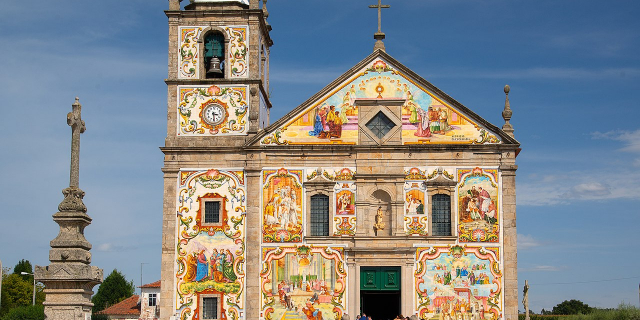Estação Ferroviária de Porto - São Bento
( São Bento railway station )São Bento railway station (Portuguese: Estação ferroviária de São Bento) is a 20th-century railway terminal in the civil parish of Cedofeita, Santo Ildefonso, Sé, Miragaia, São Nicolau e Vitória, in the municipality of Porto, district of Porto. The English translation of São Bento is Saint Benedict. The station is located in the Historic Centre of Porto, which has been declared a UNESCO World Heritage Site and as a National Monument of Portugal.
This building was constructed over a number of years, starting in 1904, based on plans by architect José Marques da Silva. The large panels of around twenty thousand azulejo tiles (551 square meters) were designed and painted by Jorge Colaço. The murals represent moments in the country's history and the multicolored panels depict rural scenes showing the people of various regions.
 The Convent of São Bento da Avé Maria that was demolished in 1892; the station was later built on this site
The Convent of São Bento da Avé Maria that was demolished in 1892; the station was later built on this site The excavation, urban decay and construction site at São Bento
The excavation, urban decay and construction site at São Bento Dusk, as the first train arrives at the temporary São Bento station in 1896
Dusk, as the first train arrives at the temporary São Bento station in 1896 Interior of the completed station
Interior of the completed stationAs early as 1864, the Guia Histórico do Viajante do Porto e Arredores (Historic Guide for the Traveller to Porto and Surroundings) implied the intention to construct a central station to be located in the Palacette of the Quinta do Cirne (Campo 24 de Agosto).[1]
In 1887, José Maria Ferreira and António Júlio Machado, aldermen, presented to the municipal council a project for a Central Station in Porto, elaborated by Hippolyte de Bare.[1] The following year, Emídio Navarro, Minister of Public Works, authorised the construction a railway line between Campanhã and a central station to be built near Praça de D. Pedro.[1]
It was finally decided to build the station on the site of the Benedictine Convent of São Bento da Avé Maria, which had been ordered built by King Manuel I of Portugal in 1518.[1] The building had been a monastery until it was destroyed by fire in 1783 and was later rebuilt for use as a convent. It was in a state of disrepair by 1892 when the last nun died and was demolished that year.[1][2]
By 1890, work on the tunnel was already underway and was completed in 1893.[1] The first train arrived at this location (before the current building was constructed) in 1896.[1] But, in 1897, there was a landslide at the opening of the tunnel on the southern edge of the station.[1] The preliminary work on a planned station along the angle of Praça Almeida Garret and Rua da Madeira began in 1900. The cornerstone was placed by King D. Carlos I.[1]
The design/build project was entrusted to Porto architect José Marques da Silva, whose design was influenced by French Beaux-Arts architecture.[1] He showed the drawings of a first concept to the authorities in May 1897 and received a contract in September 1899, with full payment. He revised the concept several times during discussions with the Public Works staff at City Hall before settling on the final design, a U shape facing the Praça Almeida Garrett (Almeida Garrett Square). In 1901, the administrative commission for the railway expanded the concept to also include a postal station.[1]
The project was approved in 1903, and construction of the actual station building started the following year.[1] The city was not satisfied with the work over the years and removed da Silva from the project in 1909.[3] Various delays led to the total project (structure and interior decor) consuming 13 years.
In September 1988, a plan was authorised to heritage list the property.[1] The first steps to renovate the site began in 1992, with work on the facades and restoration of the boxes and ceiling; this included work on the interior and exterior illumination.[1]
In October 2016, Porto Vivo-Sociedade de Reabilitação Urbana ordered that public work in constructing a hostel on the lateral facade of the station should be stopped until an official application for a license was obtained.[1] The company responsible for the installation was F2IS - Consultadora e Gestão de Projectos, which finally submitted an application on 17 October.[1] The work was completed and the business operates as "The Passenger Hostel".[4]



































Add new comment